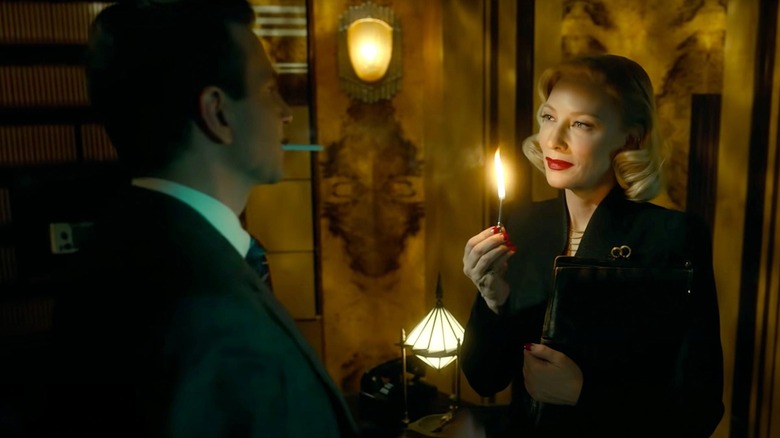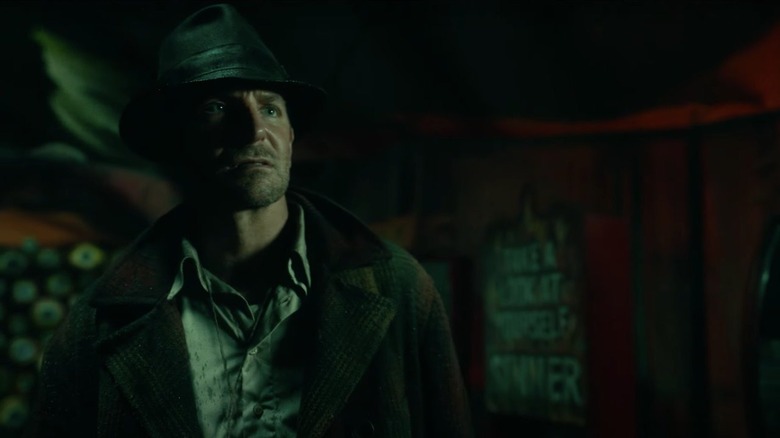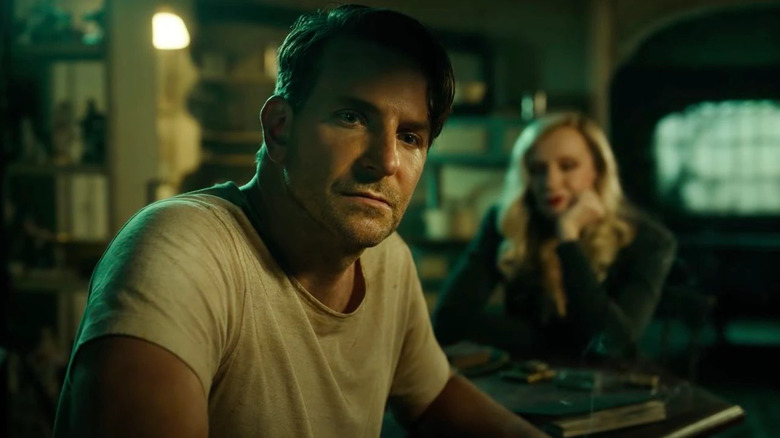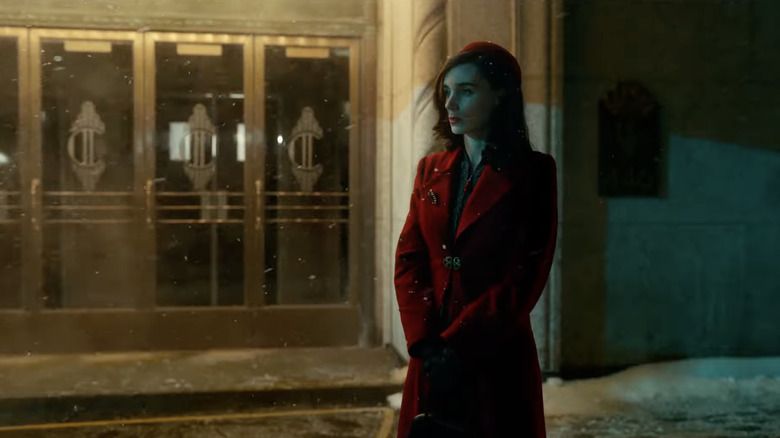Nightmare Alley Editor Cam McLauchlin On Killing His Darlings And That Incredible Final Shot [Interview]
With "Nightmare Alley," Cam McLauchlin had quite an epic film to shape in the editing room. It's a sprawling journey, starting with the ambitious Stanton Carlisle (Bradley Cooper) going from a carnival to fooling members of high society to experiencing a hard-hitting downfall. Not to mention, it's an ensemble film packed with atmosphere and an infectious passion for detail. Co-writer/director Guillermo del Toro's vision, based on William Lindsay Gresham's novel, is dense but moves with grace, thanks in large part to McLauchlin's contributions.
The editor sees himself as a drummer in a band, especially when working with del Toro: He wants to follow the filmmaker's lead and stay on tempo. During a recent interview, McLauchlin told us how he accomplished that feat — and talks about how they honed that incredible final shot. Warning: spoilers for "Nightmare Alley" ahead.
"It was a beautiful thing"
"Nightmare Alley," like "The Shape of Water," is dense but moves very elegantly. How do you and Guillermo find that rhythm?
I think it's two things. Obviously, it's just the internal rhythms Guillermo creates in camera movement. And like you say, the density of whether it's lighting, production design, everything seems to have its own natural rhythm and it's something you strive for in terms of picking performances and takes. In terms of pacing and rhythm, it's something we spent close to two years doing. There are a lot of misses before the hits.
What were some of the misses before the hits?
I think the script was 150 pages or something, so it was already a massive piece of work to undertake. We all knew going in that we were going to have a long film on our hands and we knew that in today's climate, of course there's "The Irishman" and other long films, but at some point, the film breaks under its own weight. So, the three hour and thirty minute cut didn't stand.
The thing with Guillermo is, you're constantly experimenting even up until the last minute. On the second to last day of the mix, he had this one scene that he wanted to try to make work and keep in the film. We're on the stage and he looked at me, he said, "I want to go try something." I knew what he was talking about because it's the one scene he always brings up.
What was the scene?
It didn't make the cut. It was decided a long time ago that, as good as it was on its own, it didn't help for greater good. But with Guillermo, you always are trying everything and because of the accidents that you come across, it might be the idea that leads to the idea. That is, the actual idea that makes the film better.
If you don't mind sharing, what was that deleted scene about?
Well, it was just a whole subplot of the character, Zeena, Pete, and Stan, their relationship. I don't know if I'll tell you [laughs].
[Laughs] When you say a three and a half hour cut, was that the assembly or a solid cut of the movie?
Yeah, that was assembly. I say assembly, but we're cutting daily. I'm going in there every morning and doing as fine a cut as I think at the moment, given the context of that little bubble of the scene, not in as things take shape and scenes connect to others and the blob keeps growing. Of course, you can start to make different editorial decisions, but when you get a scene, it's flabby. You keep the whole camera moving, you keep all the dialogue in.
As time takes over and the narrative starts to arise and you start to experiment with things. You're pulling lines or you're dropping scenes or coming into a scene halfway through or exiting earlier. So, that three and a half hour cut is something that you believe in for sure. It has all the elements and pieces that come from the script. Of course, the cliche thing of, you write it, you shoot it, you edit it, it's that constant evolution.
I would've liked to have seen that three and a half hour cut.
I know, it was a beautiful thing. What it comes down to really is the choices you make. You have your own sort of want for the picture and what you want to say with it, but at the same time, you have to respect it. As an audience, people aren't going to take in what you're really trying to say. If you're not exercising, sort of killing your babies and really going after things, that can affect performance and affect pace and rhythm. You do have to expect that we're going to lose some things, but the movie's going to be better for it.
"Am I ever going to leave this place?"
Like you said, you tried some experiments. Which experiments worked out?
Well, I think the most interesting thing to answer this question is, like I said, the script was quite long and oddly enough, whether you were in the carnival or Buffalo, it had a modular quality to it. Once we had the scenes shaped, and we'd have various versions of the scenes floating for the whole edit, that could be up to five different versions where you could basically take this, put it here, take this, put it back here. And within two hours, you could have a different film because of the modular aspect of it, which I haven't really had on other films.
It was uncanny that we were able to rearrange it and you could watch it. You would know certain times specifically that, 'Okay, this isn't the path,' but others, it would provoke new questions and lead to different experiments. Structurally, the film was ever-evolving. We might have cut scenes from the early onset of the post process, but a lot of scenes stayed. Surprisingly enough, they just got shorter.
Just that domino effect, too, of one wrong choice can kill it.
Oh, absolutely.
Like, if you cut too much or if the movie was even missing a minute or even a beat, maybe the final 15 minutes wouldn't be as visceral, right?
Right. Yeah, it was quite interesting last night. You were in the screening in New York or Los Angeles?
Los Angeles.
Okay. Yeah, because we'd done one test screening in L.A. for friends and family and it was 35, 40 people. We were able to get in a theater and watch it and experience it sort of fresh, the way that you do get when you're in a theater with other people. But last night was the first time I've ever seen it with a crowd. The reactions specifically to what you're talking about, the violence was quite something. The release in the room was — it felt like a wave crashing. When you have someone like Mary Steenburgen cap off this old white patriarchal man and then off herself, it is quite something.
[Laughs] That got a big laugh.
Same.
Maybe it was an uncomfortable laugh or from shock, but it's very sad.
Yeah. I could only chalk it up in the moment to being, 'Is this just a nervous reaction to let go of something so terrible?' There are people definitely that were, as soon as you feel like she's getting up and pulling something out, you're like, 'Oh no.'
You had so much story to craft. I mean, how long does Stan stay in the carnival? How long do you focus on both his rise and his fall? How'd you and Guillermo find the answers to those questions?
It was something that basically was the thesis of the film and the thing that we were trying to unpack, because you have this character who is alien-like, aimless, he's this empty vessel. He's in every scheme. What we discovered was, working with his reactions, working with him listening, especially in the carnival, there was a definite build up of how long is too long for the carnival before people start to [wonder], 'Am I ever going to leave this place?' It's something that we grappled with until the very end, but we had to build a counterpoint and we had to build a lot, like a relationship with Molly and the father figure relationships.
We had to give him the book and we had to get him to learn and be interesting enough that we want to see where he goes, because you know what's going to happen. This isn't a "Seabiscuit” version of "Nightmare Alley." Finding Stan in that balance, that was the thing that we spent the most time shaping.
"What take did you use, was it three or five?"
Speaking of timing, that final shot is maybe the best of the year. How'd you and Guillermo decide on its length and when exactly to cut to black?
You know what, I remember Guillermo shot that and he called me on the way home. This may go down in film lore, because I feel like there were five takes, but Guillermo said there were six and Bradley said there were seven. I'm pretty sure we used take three. But Guillermo asked, "What take did you use, was it three or five?" I said three. It's the take that we have in the film, or it's take one depending on who you ask, but initially we cut it off at the laugh and we had it like that for a very long time. And then in the edit, usually the mistakes led to the discovery. We kept playing the dailies, just looking for something.
I think it might even be just finding sound, because there were creaks on the chair and then all of a sudden you discover, 'Oh my God, look what happens.' I think initially, tonally, I was trying to tap into the hysteria that his brain has become and what an insane journey. Once we played past that and you see the real torture and the way his eyes just kind of flick off at the end, we knew instantly that we had to extend it.
You said you have to kill your darlings, so which darlings did you kill?
Well, there was a relationship. Obviously, when Stan arrives at the carnival, he gets a handjob in the bathtub, and then fade to black and now he's part of the team. There was a relationship to Zeena and Stan that we really struggled with how much to tap into and lean into because there was footage for it. It started to erode Molly and Stan's relationship. We really needed to land that relationship, because like I said earlier, when they're leaving the carnival, we need to be behind them.
When Stan runs into the tent after he reads the marshal and he really believes in himself at that point, this is the part of him as a character that's interesting to me. He does have these redeeming sympathetic qualities and moments and you see glimmers of humanity, but then he always fails himself. He found an angel in a carnival and whether or not he used the spook show, he just kept going with it and totally corrupted himself. He was warned by Pete, he was warned by Zeena, and even Lilith basically gives him an out. Lilith says, 'You don't know who I am,' but he just keeps going because he's this sort of robot. He's going to just go all the way, like, 'I have no other prospects, maybe this is my calling.'
That reminds me, a line I love in the original film that was on my mind during this version was, "How does a man get so low? He reached too high."
Oh my God, what a beautiful line.
Did you and Guillermo talk at all about the original adaptation?
I always feel like I ask directors this question of, 'Do you want me to know anything?' He was very flat and just said, no, and I've always tried to go into things pretty open and not have too much predetermination of the material other than read the script, study the script, know where we're coming from. Beyond that, I don't want to interject too much thought other than, especially with Guillermo because he's such a world builder and tone builder, that I can never imagine what's going to come. For me, it was just: Get the dailies and start putting them together.
"Nightmare Alley" is now in theaters.



